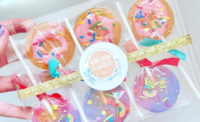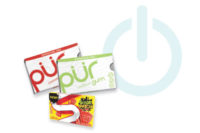Walk along any candy aisle these days, and you’ll see a new form of packaging sweeping the section — re-sealable bags. And all those re-sealable bags are filled with the only candy that makes sense for a bag that can be delved into again and again and again —bite-sized candies, of course.
Chewy Candy brands ranging from Jolly Rancher to Airheads are getting in on the action, which only leaves one questions: Who knew bite-sized could be so huge?
In fact, chewy candy is so perfect for that type of packaging, that not only are brands that are traditionally chewy candies appearing in re-sealable bags, but so are brands that are traditionally hard candies.
Companies like Wrigley have come out with Life Savers Berry Bites Gummies, while Hershey has introduced Jolly Rancher Soft and Chewy Bites.
“The Jolly Rancher Gummies leverage our bold, fruit flavor equity,” says James Kilts, brand manager - Jolly Rancher. “In late April 2014, we will be adding Jolly Rancher Filled Gummies Bites that will continue the expansion of our brand portfolio by bringing Jolly Rancher’s bold fruit flavors to another form.”
All this is not to say that brands that are traditionally chewy candies are being left behind. For example, Wrigley has also introduced Starbust Minis, which are sold in 8-oz., re-sealable stand-up pouches and 3.5-oz. Share Size packs.
“With these innovations, we’re making it easier and more convenient for people to enjoy chewy products from two of our well-loved brands,” says Caroline Sherman, U.S. manager of marketing communications, Wrigley.
And, Perfetti Van Melle USA has recently launched both Airheads Bites and Airhead Xtremes Bites.
“[They’re] bite-size pieces that have the same great flavor as the original but are now easier to eat and pop-able,” says Jen Redmond, Associate Brand Manager, Airheads. “Airheads Bites are loved by all our customers, including an older audience who likes how they fit into their on-the-go lifestyle.”
Indeed, all this bite-size candy must be working. The chewy candy category has grown nearly six percent over the last year, reaching $2.8 billion in total sales, according to data from IRI, a Chicago-based market research firm.
And it’s not just familiar brands getting in on the action. Newer companies like Lovely Candy have also found success in the growing segment.
The company’s fruit chews are individually wrapped, and available in a stand-up pouch format. And they also offer caramels and fudge rolls. Unlike some of the mainstream companies, Lovely differentiates itself by focusing on its ingredient list.
Its entire line is gluten-free, non-GMO, with no artificial flavors, colors or high fructose corn syrup. Its caramels contain rBST-free dairy and the fruit chews are vegan. And, all the products are perfect for people with food sensitivities or celiac disease.
“Our fruit chews use real fruit bits, which is very innovative,” says Mike Nakamura, Lovely Candy’s ceo.
But Lovely Candy is nowhere near done innovating. The company is planning to introduce a new treat at this year’s Sweets and Snacks Expo, it’s what Nakamura believes to be the first U.S.-made, extruded, gluten-free licorice, Lovely Licorice.
“The introduction of our new gluten-free licorice is a major movement for the industry, I believe,” Nakamura says. “[We’re] taking a staple like licorice and serving it up to the masses in a way that is well accepted and feels ‘mainline’ yet special.”
He admits that Lovely’s products tend to be a little more expensive than the average chewy candy, but he says the company works hard to win over every customer who gives them a chance.
“Better ingredient confections taste better,” Nakamura explains. “Not everyone is going to pay a small premium, but if you can win on flavor at every trial, the market expands accordingly.”
All their hard work must be paying off. Lovely Candy was recently picked up by Target.
“Target is an ideal retail partner for Lovely Candy. We share a desire to continually innovate and merchandise offerings with high quality ingredients,” Nakamura says. “Target’s consumer base is the perfect fit for our premium products.”
Meanwhile, Airheads has a different strategy for spurring growth. It’s focusing on an older consumer.
“One of our overall goals for the brand is to “up-age” our customer and promote Airheads to a millennial target audience who loved Airheads as a kid, but are not considering them currently,” Redmond says.
Redmond explains that Millennials, traditionally seen as consumers born between 1981 and the early 2000s, make up 42 percent of all non-chocolate candy consumption.
In an effort to target that group, Airheads had launched a new marketing campaign, “The World Needs More Airheads.”
The campaign encourages fans to share videos of their own ‘Airheads’ moments for a chance to star in an upcoming commercial. The company got the ball rolling by debuting its own airheaded videos: in one a man mistakes a man for a woman, and in another a girl accidentally throws a bowling ball at a ceiling instead of rolling it down the lane.
“We believe that the campaign strategy of celebrating and sharing airheaded moments is not only a natural fit with the brand but also natural fit with the social platforms millennial targets are already using,” Redmond says.
As for the future of chewy candy, Airheads says they expect the bite-sized candy offerings and re-sealable packing trends to continue to grow.
And Nakamura says the chewy candy category should take note of how chocolate products have evolved over the last few years — introducing new flavor profiles, and mixing contrasting, yet complimentary flavors.
If any of those ideas are even half as big as the bite-sized trend, they’ll be huge.












